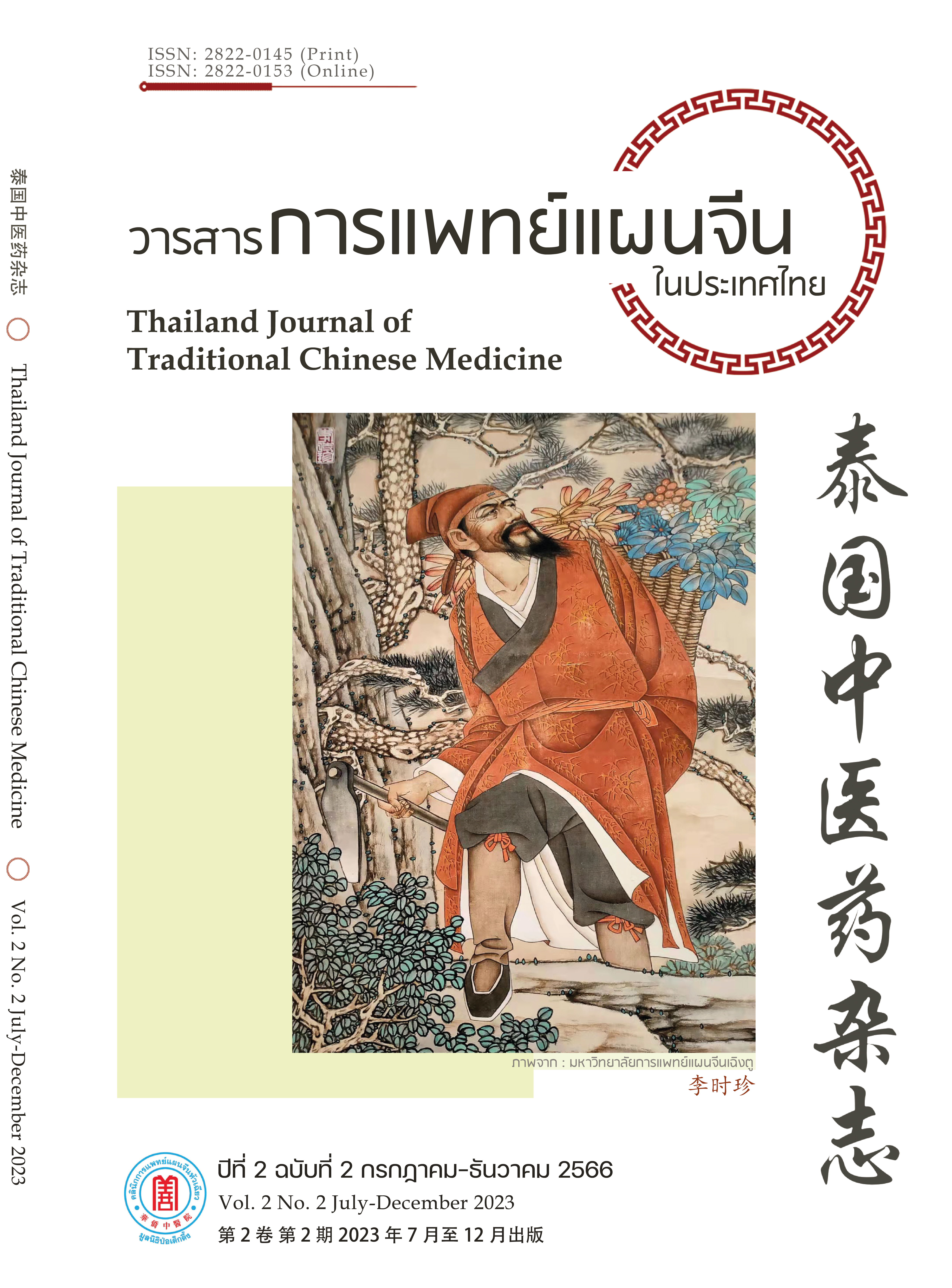ความก้าวหน้าด้านการศึกษาถึงความสัมพันธ์ของอินผิงหยางมี่และสารต้านอนุมูลอิสระภายในร่างกายที่นำมาประยุกต์ใช้ในการนวดทุยหนา
Main Article Content
บทคัดย่อ
อินผิงหยางมี่เป็นความสมดุลของอินหยางแบบพลวัต ซึ่งเป็นพื้นฐานร่างกายของสารสำคัญต่างๆ ในร่างกายของมนุษย์ในสภาวะร่างกายจิตใจที่เป็นปกติ มีการกล่าวถึงครั้งแรกในคัมภีร์หวงตี้เน่ยจิง ว่า “หากอินชี่สงบ หยางถูกกักเก็บอย่างสมดุลกัน ร่างกายจิตใจก็จะเป็นปกติ หากอินหยางแยกจากกัน ร่างกายจิตใจก็จะดับสูญ” สุขภาพร่างกายของคนเราขึ้นอยู่กับสมดุลของอินและหยาง ถ้าอินหยาง ชี่ เลือด และอวัยวะต่างๆ ทำงานผิดปกติ โรคต่างๆ ก็จะเกิดขึ้น ในช่วงหลายปีที่ผ่านมาให้ความสำคัญกับการวิจัยทางชีวโมเลกุลเกี่ยวกับสารอนุมูลอิสระที่เกิดขึ้น มีผลต่อสุขภาพของร่างกายมากขึ้น การนวดด้วยศาสตร์การแพทย์แผนจีนก็เริ่มมีการวิจัยมากขึ้นถึงสารอนุมูลอิสระ พบว่าการนวดจะช่วยกระตุ้นการไหลเวียนของชี่และเลือด สามารถแก้ไขปรับปรุงสภาวะขาดเลือดและขาดออกซิเจนของเนื้อเยื่อได้ และการสามารถแก้ไขอนุมูลอิสระที่แปรปรวนผิดปกติได้ เป็นต้น ซึ่งในบทความนี้กล่าวถึงความสัมพันธ์ของอินหยางตามทฤษฎีของศาสตร์การแพทย์แผนจีนและสารต้านอนุมูลอิสระภายในร่างกาย การรวบรวมความก้าวหน้าด้านการวิจัย เพื่อเป็นประโยชน์ในการนำแนวคิดไปประยุกต์ใช้ในการรักษาต่อไป
Article Details
เอกสารอ้างอิง
Zheng HX. Basic theory of TCM (thirteenth five-year plan textbook). 4th ed. Beijing: China Traditional Chinese Medicine Publishing House; 2016. (in Chinese)
Wang ZH, Yu TY. Science of tuina (twelfth five-year plan textbook). 9th ed. Beijing: China Traditional Chinese Medicine Publishing House; 2019. (in Chinese)
Gao ZP, Rong RF. Explanation of ‘relative equilibrium of yin-yang’. China Journal of Traditional Chinese Medicine and Pharmacy. 2017;32(7):2975-7. (in Chinese)
Wang QB, Xu FP, Wei CX, Peng J, Dong XD. Research progress on free radicals in human body. Chinese Journal of Epidemiology. 2016;37(8):1175-82. (in Chinese)
Liu KM. Free radicals: functions, types and its source. Oxidants and Antioxidants in Medical Science. 2022;11(2):1-2.
Kumar SB. Free radicals and antioxidants: human and food system. Advances in Applied Science Research. 2011;2(1):129-35.
American Public University. Generation of free radicals in the body. In: Byerley L, editor, Basic foundation of nutrition for sports performance. Open access edition. West Virginia: LibreTexts; 2023. p.6021.
Zhang YZ. Discuss on the relationship between yin and yang of the human body and metabolism. Journal of Basic Chinese Medicine. 1999;5(11):57-60. (in Chinese)
Wang D, Song H. Brief discussion of “immunity” and “both yin and yang in equilibrium” relation. Journal of Liaoning College of Traditional Chinese Medicine. 2010;12(9):109-10. (in Chinese)
Liu CZ, Lei B. Effect of tuina on oxygen free radicals metabolism in patients with chronic fatigue syndrome. Chinese Acupuncture & Moxibustion. 2010;30(11):946-8. (in Chinese)
Wang QJ, Dong LJ, Jiang XF, Zhang RX, Xu DK, Bai YS, et al. The efficacy of acupuncture combined with tuina and traction treatment lumbar disc herniation with blood stasis type and effect on free radical metabolism in patient. Shaanxi Journal of Traditional Chinese Medicine. 2018;39(9):1304-7. (in Chinese)
Wang MY, Gong MG, Fang M. Discussion on the mechanism of pain relief by massage therapy. Acta Universitatis Medicinalis Anhui. 1991;26(4):241-5. (in Chinese)
Li ZM, Liu JW, Wu YH, Wang MY, Fang M, Wang YL, et al. Effect of massage on free radical metabolism in patients with lumbar disc herniation and cervical spondylosis. Journal of Traditional Chinese Medicine. 1993;34(7):416-8. (in Chinese)
Zou B. The study on massage treatment to nerve root type cervical spondylosis [dissertation]. Acupuncture and tuina science. Shandong: Shandong University of Traditional Chinese Medicine; 2005. (in Chinese)
Hao J. Study on mechanism of chronic fatigue syndrome (spleen and kidney yang deficiency type) with back massage [dissertation]. Acupuncture and tuina science. Changchun: Changchun University of Chinese Medicine; 2023. (in Chinese)
Li JY, Li HN, Tang JX, Wu QJ, Zhang HN, Wang JG. Research progress on the neurobiological mechanism of abdominal massage. Global Traditional Chinese Medicine. 2023;16(8):1695-700. (in Chinese)
Cheng XP, An FY, Li XY, Yan CL, Jin AS, Niu YQ, et al. Study on the mechanism of anti-hypoxic injury of Chinese medicine compounds for replenishing qi and promoting blood circulation and removing blood stasis. Chinese Journal of Basic Medicine in Traditional Chinese Medicine. 2021;27(2):345-50. (in Chinese)


